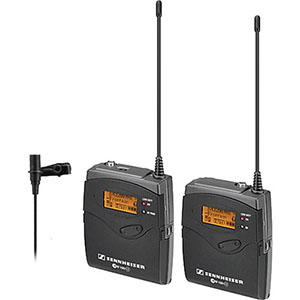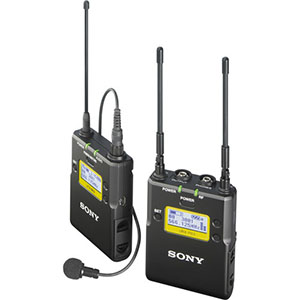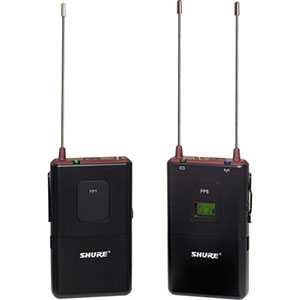This article looks at five important wireless microphone systems that are the standard fixtures at productions around the world. Why use wireless systems at all? Three reasons:
- To avoid cables, especially when multiple microphones are required.
- To hide cables so it won’t show in the shot – important when you’re covering a long shot and can’t show cables running down the pants of your lead artist.
- When the distance to transmission is too large and impractical for cables.
Just to be sure, even though I call this a wireless ‘microphone’ system, it doesn’t really involve the microphone. However, for video production, such systems are mostly used to interface remote microphones with mixers or recorders. For general communication, walky-talkies are better, and more legal.
The main features of a wireless microphone audio system
A wireless audio system contains just two parts:
- Transmitter – connects to the microphone and transmits the signal wirelessly
- Receiver – connects to the mixer or recorder and receives the wireless signal transmitted
Sometimes the transmitter and receiver is the same instrument, and is called a tranceiver. You still need two of them, though.
Here’s what it looks like:

When choosing wireless systems, here are the important ‘technical’ considerations (in addition to audio quality) one must keep in mind:
- Transmitting power, measured in mW or milli Watts (sometimes written as ‘mw’) – this decides how much range/distance it can transmit over. Usually 10-125 mW.
- Frequency band/group – it is expensive to have one system efficiently transmit all frequencies of the spectrum. Moreover, if a certain range is illegal, it is pointless to waste resources on it. For this reason, you’ll find systems divided into different ‘frequency blocks’. Choose the one important to you.*
- Resistance to interference – needs to be tested in the real world, every other way is too complicated and unnecessary. Low frequencies are better generally because they ‘bend around’ walls better. If you’re in an area with a lot of ‘chatter’ things will quickly get complicated.
- Reliability – how strong is the signal from end to end? The number and type of antennas tells us how reliable it is. More than one is always good.
*For Sennheiser, click here to know what frequencies are appropriate for your region (US only). For Lectrosonics, click here (or use the Television Station Lookup). When in doubt, ask other audio professionals in your area, and also reconfirm with the dealer/manufacturer directly. Some frequencies and transmitters might be legal in one country while illegal in another. This is your responsibility to figure out.
It is not uncommon for audio professionals to dump the microphones that come with these kits and use their own preferences instead.
- For 5 budget wired lavalier microphones, click here.
- For 5 budget studio microphones, click here.
- For 5 budget shotgun/boom microphones, click here.
The common input and output connectors are LEMO, XLR, 1/4″ or 3.5mm TRS. In many cases you’ll need additional adapters.
Five important wireless audio systems you should be aware of
Here, in order of price (proprietary microphone, transmitter and receiver only) are five important wireless audio systems for video production:
1 Sennheiser G3 series (also the earlier G2) (About $600 starting)
This is my ‘silver standard’. If you’re looking for a budget wireless system that is tried and tested, and used around the world, the Sennheiser G3 (and the older G2) is all you need to look at.
The specifications include:
- 30 mW transmitting power
- 110 dB dynamic range
- 3.5mm TRS input and output
- Runs on 2 AA batteries
The standard kit includes a ME-2 lavalier microphone, which is the only part I don’t like.
The next two systems are replacements/competitors to the Sennheiser system.
2 Sony UWP-D11 (about $600 starting)
Where there’s video, there’s Sony. Sony’s products are rugged and can withstand the trials and tribulations of production.
- 30 mW transmitting power
- 86 dB dynamic range
- 3.5mm TRS input and output
- Runs on 2 AA batteries, can be recharged via USB
The kit includes a Sony ECM-V1BMP lavalier microphone.
3 Shure FP (about $465 without microphone)
There are people who say the Shure is mainly used in the music/concert/events space and are not that great for video production work. If it works for those tough environments, it can withstand the demands of video production as well.
- 10-30 mW transmitting power
- 100 dB dynamic range
- 4-pin TA4F LEMO input connector, TA3F output connector
- Runs on 2 AA batteries
The next two systems are what one can call ‘industry standards’.
4 Lectrosonics 400 series receiver and LMa transmitter (about $2440 without microphone)
Lectrosonics is one of the industry standards for cinema audio. You can’t go wrong with these. Lectrosonics also offers a cheaper 100 series receiver, but I’ve heard these are better. The transmitter is LMa for both.
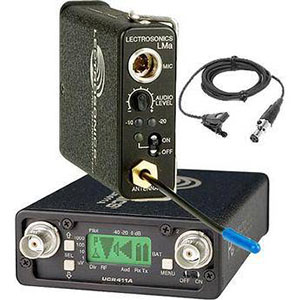
The specifications include:
- 50 mW transmitting power
- 113 dB dynamic range
- TA5 male input connector, XLR male output
- Runs on a 9V battery (Li, LiPo or Alkaline)
5 Zaxcom TRXLA2 tranceiver (about $3500 without microphone)
You could arguably call this the gold standard of wireless systems for video production, though I’m confident many would disagree.
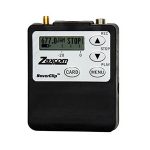
The specifications include:
- 25, 50 and 125 mW transmitting power choice
- 126 dB dynamic range
- 3-pin LEMO inputs/outputs
- Runs on 2 AA batteries
There you are. You can see that the higher-end models offer more dynamic range, more transmission power, etc. I’ve barely scratched the surface here, and this list is only intended as a ‘point-of-entry’ information piece. You must now do further research on what makes each system special, and different, and then choose the best one for your needs.

